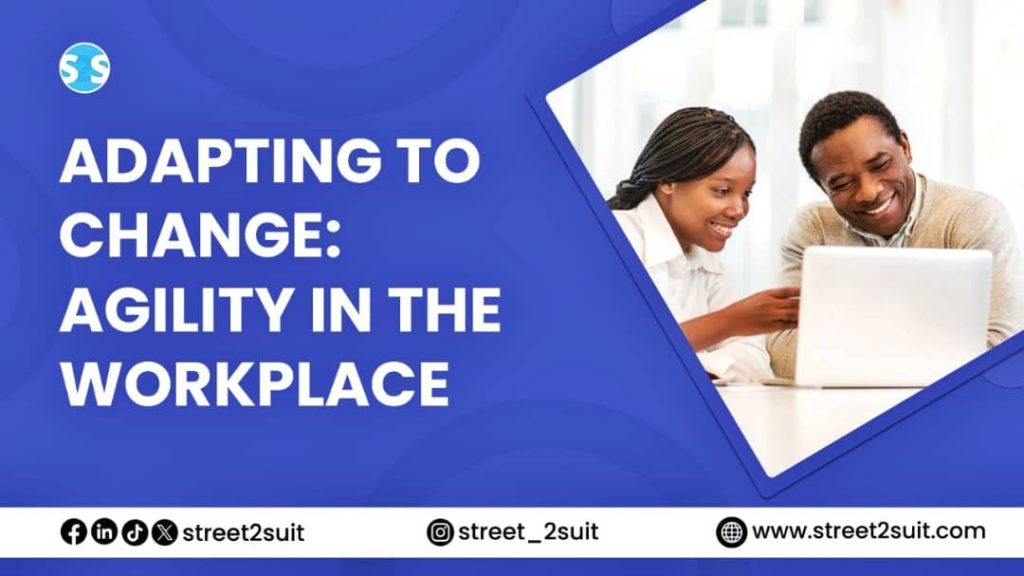Change in the workplace is like a mysterious software update—you don’t always know what’s coming, but you’d better adapt. It’s going to happen whether you’re ready or not, and sometimes it causes just enough chaos to test your patience.
Whether it’s a shift in leadership, a merger, a sudden switch to hybrid work, or the roll-out of new software that no one asked for, change is inevitable. But what separates employees who merely survive change from those who thrive in it? It’s one word ‘Agility’.
In the corporate world, adaptability is key to success. With technological advancements, shifting market trends, and evolving workforce dynamics, organizations must be agile to stay ahead.
Adapting to Change: Agility in the Workspace
Let’s explore what agility in the workplace really means, why it matters more than ever, and how to flex your adaptability muscles without breaking a sweat.
What Is Workplace Agility, Anyway?
Workplace agility isn’t just a trendy buzzword used in team-building seminars that involve too much trust-falling. At its core, agility is the ability to adapt quickly and effectively to changing circumstances, challenges, and expectations.
It means staying resilient, solution-oriented, and open-minded, even when your to-do list just grew five new bullet points labeled “URGENT.” Agile employees don’t panic in the face of the unexpected, they pivot, adjust, and keep moving forward. Think of agility as your internal career yoga, flexibility, balance, and the occasional deep breath are essential.
Why Agility Matters in Today’s Workplace
In the fast-paced, tech-evolving, acronym-loving world of modern work, change comes faster than a Slack notification. The pandemic taught us all that being adaptable isn’t optional—it’s survival.
Here’s why agility is essential:
Constant Innovation: New tools, platforms, and processes are introduced regularly. Agility fosters a culture of innovation, it helps you stay ahead instead of getting left behind.
Staying competitive : Adaptability enables organizations to respond quickly to changing market conditions, staying ahead of the competition.
Shifting Work Models: Hybrid, remote, asynchronous—the way we work is changing. Those who can shift gears quickly are in demand.
Economic Uncertainty: Layoffs, budget cuts, and restructuring are real. Agility helps you roll with the punches.
Career Progression: Employers value employees who can learn new skills, embrace change, and take initiative—even in uncertain conditions.
Spoiler: If your response to change is “We’ve always done it this way,” you might be the reason the team hides in conference rooms.
Signs You’re an Agile Employee or on Your Way to Being one
Wondering if you already possess workplace agility? You might be more adaptable than you think if:
- You respond to new challenges with curiosity instead of complaints.
- You’re open to feedback and use it to grow.
- You embrace learning opportunities even if they involve yet another Zoom webinar and extra time.
- You pivot when plans change without needing a therapy session.
- You encourage collaboration and keep communication open during transitions.
If you checked at least three of these, congratulations, you’re halfway to workplace ninja status.
How to Cultivate Agility in the Workspace
So how do you go from “change-averse” to “change champion”? Here are some practical and not painful strategies:
Adopt a Growth Mindset
A growth mindset, coined by psychologist Carol Dweck, is the belief that abilities and intelligence can be developed. In other words, you can teach an old spreadsheet new tricks.
When facing a change, ask yourself: What can I learn from this? How can this help me grow? What skills can I strengthen here? Instead of fearing failure, see it as a stepping stone to improvement, preferably one that doesn’t involve an IT meltdown.
Stay Curious
Agile employees are curious cats. Ask questions, explore new ideas, and seek out trends in your industry. Being curious keeps you ahead of the curve and makes you the go-to person when others are still figuring out what changed.
Subscribe to newsletters, listen to career podcasts, or follow industry leaders on LinkedIn. Yes, scrolling LinkedIn can be productive.
Be Proactive, Not Just Reactive
Agility doesn’t mean waiting for change to come and then scrambling. It means anticipating it and preparing like a workplace Boy or Girl Scout.If you hear whispers about a departmental shake-up or a tech upgrade, don’t hide under your desk. Ask questions, volunteer to test tools, and position yourself as a forward-thinker. Bosses love that stuff.
Communicate Openly and Often
Agility thrives on strong communication. During change, confusion spreads faster than office gossip.Speak up when you have concerns, share ideas for navigating transitions, and be a sounding board for teammates. Clear, calm communication not only helps you adapt, it makes you a steady presence for others.
Build a Support System
Adapting is easier when you’re not doing it alone. Lean on your colleagues, mentor someone, or join a peer support group. When you surround yourself with people who are also learning and growing, change feels less scary and more like a team sport.
Practice Self-Compassion
Be kind to yourself. Adjusting to new ways of working is stressful, and agility doesn’t mean never struggling, it means getting back up when you do.Take breaks, celebrate small wins, and remember, you don’t have to have it all figured out on day one. Even superheroes take off the cape sometimes.
Agility Is the Superpower of the Future
In an era where jobs evolve, industries shift, and entire departments disappear faster than your leftover sandwich in the office fridge, agility isn’t a “nice-to-have.” It’s your secret weapon.Being agile means you’re always learning, always adapting, and always bringing value, even when the work world turns upside down.
So the next time your manager says, “We’re trying something new,” don’t panic. Stretch those adaptability muscles, take a deep breath, and channel your inner workplace power. You’ve got this. And if you don’t, you’re about to learn how.
Receive the latest job and career updates in your inbox, every week!
Mariam is an imaginative and meticulous writer who is passionate about crafting compelling narratives and translating concepts into influential content.




